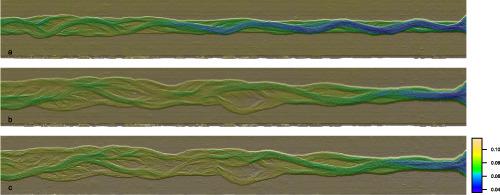当前位置:
X-MOL 学术
›
Earth Surf.Process. Land.
›
论文详情
Our official English website, www.x-mol.net, welcomes your
feedback! (Note: you will need to create a separate account there.)
Channel stability in steep gravel–cobble streams is controlled by the coarse tail of the bed material distribution
Earth Surface Processes and Landforms ( IF 2.8 ) Pub Date : 2020-09-03 , DOI: 10.1002/esp.4994 Brett C. Eaton 1 , Lucy G. MacKenzie 1 , William H. Booker 1
Earth Surface Processes and Landforms ( IF 2.8 ) Pub Date : 2020-09-03 , DOI: 10.1002/esp.4994 Brett C. Eaton 1 , Lucy G. MacKenzie 1 , William H. Booker 1
Affiliation

|
Researchers have associated channel‐forming flows with reach‐average shear stresses close to the entrainment threshold for the surface D50. We conducted experiments using a model of a generic steep, gravel–cobble stream to test this association. Our results suggest that channel‐forming flows fully mobilize the D50, and produce shear stresses close to the entrainment threshold for the largest grains in the bed. The channel dimensions were set by flows capable of mobilizing between 85% and 90% of the bed surface, which produced a brief period of lateral instability lasting about 1 h, followed by a prolonged period of relative stability during which modest adjustments occurred, but during which the reach‐average hydraulics remained about the same. The adjustments during the unstable phase of the experiments are characterized by rapid bank erosion, extensive deposits on the channel bed and a restructuring of the major morphologic elements of the stream. The adjustments during the stable phase of the experiments involved barform migration and bed surface coarsening but did not appreciably modify the physical template established by the end of the unstable phase. The behaviour we observed is not consistent with the concept of a dynamic equilibrium associated with a formative flow that is just capable of entraining the bed surface D50. Instead, it suggests that rapid adjustments occur once a stability threshold is exceeded, which creates a template that constrains channel activity until another event drives the system across the stability threshold, and re‐sets the template. While we believe that it is probably too simplistic to associate a channel‐forming discharge with the entrainment threshold for a single grain size, our results suggest that the D95 is a more logical choice than the D50 © 2020 John Wiley & Sons, Ltd.
中文翻译:

陡峭的卵石-卵石流中的河道稳定性受床层物质分布的粗尾控制
研究人员将通道形成流与到达平均剪切应力接近表面D 50的夹带阈值相关联。我们使用通用的陡峭的卵石卵石流模型进行了实验,以测试这种关联。我们的结果表明,渠道形成的流动完全动员了D 50,并且产生的剪切应力接近床中最大晶粒的夹带阈值。通道尺寸由能够在床面面积的85%至90%之间移动的流动设定,这会产生短暂的横向不稳定状态,持续约1小时,随后是相对稳定的时间段,在此期间会进行适度的调整,但在触及平均水力保持不变。在实验的不稳定阶段进行的调整具有以下特点:快速的河岸侵蚀,河床上的大量沉积物以及河流主要形态元素的重组。在实验的稳定阶段进行的调整涉及棒形迁移和床表面粗化,但并未明显改变不稳定阶段结束时建立的物理模板。D 50。相反,它表明一旦超过稳定性阈值,就会进行快速调整,这将创建一个模板来约束通道活动,直到另一个事件使系统超过稳定性阈值并重新设置模板为止。虽然我们认为它可能是过于简单化的通道形成流量与单一粒度夹带的阈值相关联,我们的研究结果表明, d 95比一个更合乎逻辑的选择d 50 ©2020约翰·威利父子有限公司。
更新日期:2020-11-03
中文翻译:

陡峭的卵石-卵石流中的河道稳定性受床层物质分布的粗尾控制
研究人员将通道形成流与到达平均剪切应力接近表面D 50的夹带阈值相关联。我们使用通用的陡峭的卵石卵石流模型进行了实验,以测试这种关联。我们的结果表明,渠道形成的流动完全动员了D 50,并且产生的剪切应力接近床中最大晶粒的夹带阈值。通道尺寸由能够在床面面积的85%至90%之间移动的流动设定,这会产生短暂的横向不稳定状态,持续约1小时,随后是相对稳定的时间段,在此期间会进行适度的调整,但在触及平均水力保持不变。在实验的不稳定阶段进行的调整具有以下特点:快速的河岸侵蚀,河床上的大量沉积物以及河流主要形态元素的重组。在实验的稳定阶段进行的调整涉及棒形迁移和床表面粗化,但并未明显改变不稳定阶段结束时建立的物理模板。D 50。相反,它表明一旦超过稳定性阈值,就会进行快速调整,这将创建一个模板来约束通道活动,直到另一个事件使系统超过稳定性阈值并重新设置模板为止。虽然我们认为它可能是过于简单化的通道形成流量与单一粒度夹带的阈值相关联,我们的研究结果表明, d 95比一个更合乎逻辑的选择d 50 ©2020约翰·威利父子有限公司。











































 京公网安备 11010802027423号
京公网安备 11010802027423号